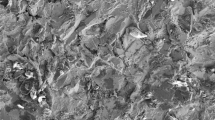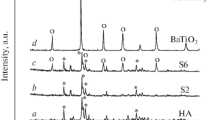Abstract
Pulsed laser deposition technique is one of the methods to coat the hydroxyapatite on 316L stainless steel and Ti–6Al–4V implants, which is used in orthopaedics and dentistry applications. In this study, hydroxyapatite (HAP) ceramics in the form of calcium phosphate were deposited on Ti–6Al–4V and 316L stainless steel by the pulsed laser deposition method. The coated thin film was characterised by X-ray diffraction (XRD), scanning electron microscopy with energy-dispersive spectroscopy (EDS) and atomic microscopy. The corrosion studies were carried out on coated and uncoated samples using potentiodynamic polarisation studies in simulated body fluid (Hanks’ solution). The bioactivity of the Hap-coated samples on Ti–6Al–4V and 316L stainless steel was evaluated by immersing them in simulated body fluid for 9 days. XRD and EDS analyses confirmed the presence of HAP. The corrosion studies showed that the treated samples have better corrosion resistance compared to Ti–6Al–4V and 316L stainless-steel substrates. The formation of apatite on treated samples revealed the bioactivity of the HAP-coated substrates. HAP-coated Ti–6Al–4V provides higher corrosion protection than the HAP-coated 316L stainless-steel substrates.







Similar content being viewed by others
References
Wang RR, Welsch GE, Monteiro O (1999) Silicon nitride coating on titanium to enable titanium–ceramic bonding. Biomed Mater Res 46:2–262
Kuo MC, Yen SK (2002) The process of electrochemical deposited hydroxyapatite coatings on biomedical titanium at room temperature. Mater Sci Eng 20:153–160
Thian ES, Khor KA, Loh NH, Tor SB (2001) Processing of HA-coated Ti–6Al–4V by a ceramic slurry approach: an in vitro study. Biomaterials 22:1225–1232
Lynn AK, DuQuesnay DL (2002) Hydroxyapatite-coated Ti–6Al–4V: part 1: the effect of coating thickness on mechanical fatigue behavior. Biomaterials 23:1937–1946
Klein C, Pratka P, van der Lubbe HB, Wolke JG, de Groot K (1991) Plasma sprayed coatings of tetracalciumphosphate, hydroxylapatite and alpha tricalciumphosphate on titanium alloy: an interface study. J Biomed Mater Res 25:53–65
Ducheyne P, Breight J, Cuckler J, Evans B, Radin S (1990) Effect of CaP coating characteristics on early post-operative bone tissue ingrowth. Biomaterials 11:531–540
Tisdel CL, Golberg VM, Parr JA, Bensuan JS, Staikoff LS, Stevenson S (1994) The influence of HA and TCP coating on bone growth into titanium fiber-metal implants. J Bone Joint Surg Am 76:159–171
Nelea V, Mihailescu IN, Jelinec M (2007) Biomaterials: new issues and breakthroughs for biomedical applications. In: Eason R (ed) Pulsed laser deposition of thin films. Wiley, New Jersey
Koch CF, Johnson S, Kumar D, Jelinek M, Chrisey DB, Doraiswamy A, Jin C, Narayan RJ, Mihailescu IN (2007) Pulsed laser deposition of hydroxyapatite thin films. Mater Sci Eng 27:484–494
Garciýa-Sanz FJ, Mayor MB et al (1997) Hydroxyapatite coatings: a comparative study between plasma-spray and pulsed laser deposition techniques. J Mater Sci Mater Med 8:861–865
Fazan F, Marquis PM (2000) Dissolution behavior of plasma-sprayed hydroxyapatite coatings. J Mater Sci Mater Med 11:787–793
Bao Q, Chen C, Wang D, Ji Q, Lei T (2005) Pulsed laser deposition and its current research status in preparing hydroxyapatite thin films. Appl Surf Sci 252:1538–1544
Mihailescu IN, Torricelli P et al (2005) Calcium phosphate thin films synthesized by pulsed laser deposition: physico-chemical characterization and in vitro cells response. Appl Surf Sci 248:344–348
Yang YC, Chang E (2001) Influence of residual stress on bonding strength and fracture of plasma-sprayed hydroxyapatite coatings on Ti–6Al–4V substrate. Biomaterials 13:1827–1836
Yang YC, Chang E, Hwang BH, Lee SY (2000) Biaxial residual stress states of plasma-sprayed hydroxyapatite coatings on titanium alloy substrate. Biomaterials 21:1327–1337
Sergo V, Sbaizero O, Clarke DR (1997) Mechanical and chemical consequences of the residual stresses in plasma sprayed hydroxyapatite coatings. Biomaterials 18:477–482
Tsui YC, Doyle C, Clyne TW (1998) Plasma sprayed hydroxyapatite coatings on titanium substrates part 1: mechanical properties and residual stress levels. Biomaterials 19:2015–2029
Fernandez-Pradas JM, Sardin G et al (1998) Hydroxyapatite thin films by excimer laser ablation. Thin Solid Films 317:393–396
Mohan L, Dilli Babu P, Kumar Prateek, Anandan C (2013) Influence of zirconium doping on the growth of apatite and corrosion behavior of DLC-coated titanium alloy Ti–13Nb–13Zr. Surf Interface Anal 45:1785–1791
Baeri P, Torrisi L, Marino N, Foti G (1992) Ablation of hydroxyapatite by pulsed laser irradiation. Appl Surf Sci 54:210–214
Koch C et al (2007) Pulsed laser deposition of hydroxyapatite thin films. Mater Sci Eng C 27(3):484–494
Torrisi L (1994) Structural investigations on laser deposited hydroxyapatite films. Thin Solid Films 237:1–2
Dinda GP, Shin J, Mazumder J (2009) Pulsed laser deposition of hydroxyapatite thin films on Ti–6Al–4V: effect of heat treatment on structure and properties. Acta Biomater 5:1821–1830
Fernandez-Pradasa JM, Serraa P, Morenzaa JL, De Azab PN (2002) Pulsed laser deposition of pseudowollastonite coatings. Biomaterials 23:2057–2061
Anandan C, Mohan L (2013) In vitro corrosion behavior and apatite growth of oxygen plasma ion implanted titanium alloy β-21S. JMEPEG. https://doi.org/10.1007/s11665-013-0628-6
Acknowledgements
The author acknowledges the Centre for Nanoscience and Nanotechnology, SRM University for using the laboratory facilities. Author would like to thank Mr. Murali, NRC, SRM University for FESEM studies, and Mr. Bijo Joseph, Department of Physics and Nanotechnology, SRM University for XRD analysis.
Author information
Authors and Affiliations
Corresponding author
Rights and permissions
About this article
Cite this article
Gnanavel, S., Ponnusamy, S., Mohan, L. et al. In Vitro Corrosion Behaviour of Ti–6Al–4V and 316L Stainless Steel Alloys for Biomedical Implant Applications. J Bio Tribo Corros 4, 1 (2018). https://doi.org/10.1007/s40735-017-0118-8
Received:
Revised:
Accepted:
Published:
DOI: https://doi.org/10.1007/s40735-017-0118-8




